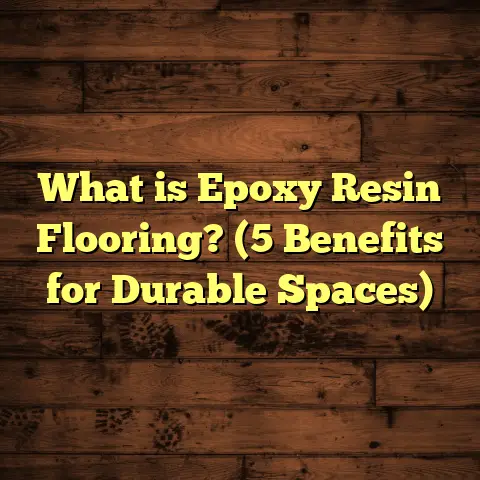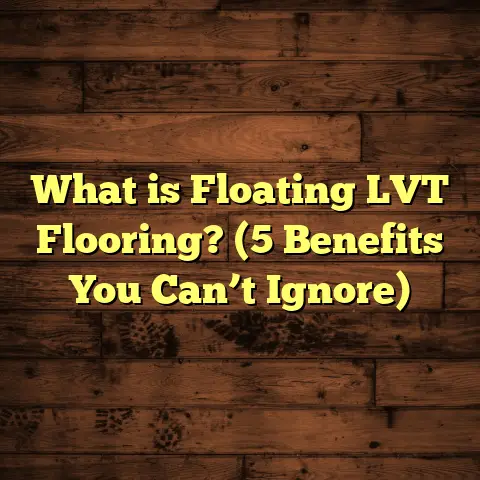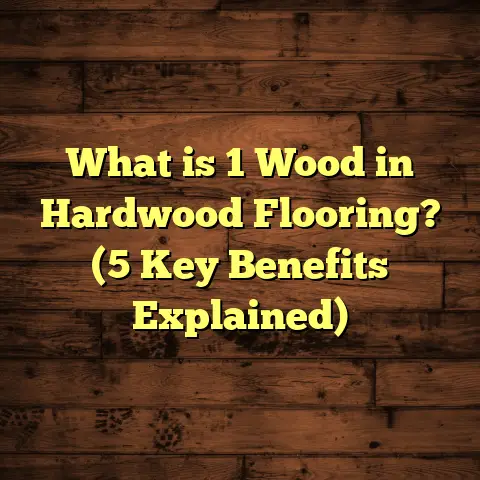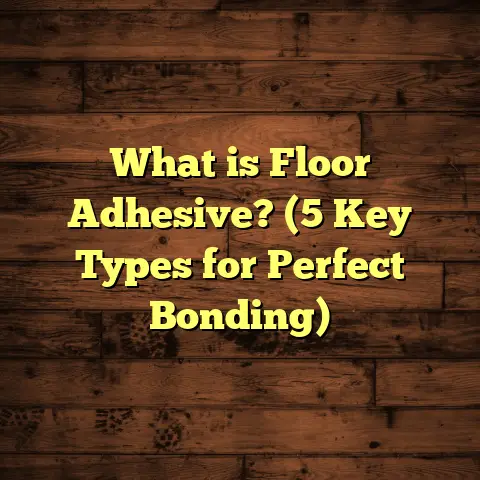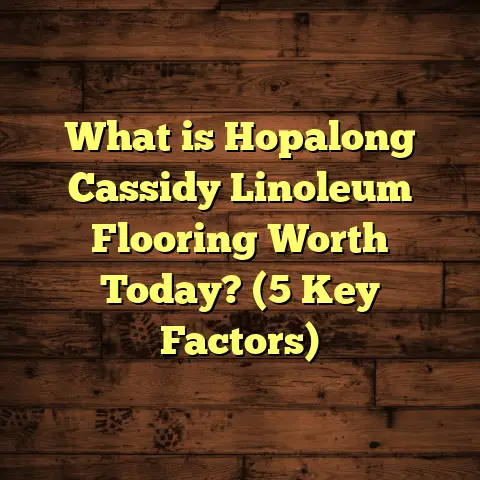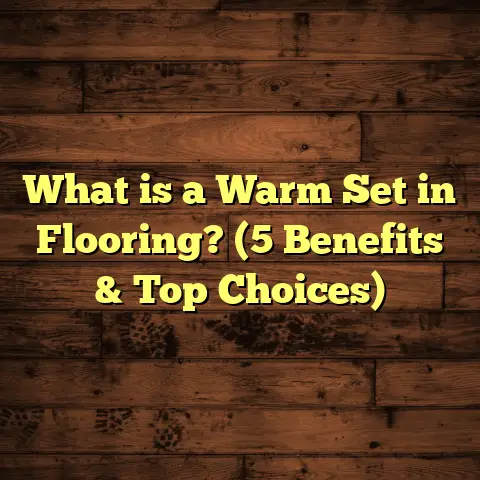What is Veneer Flooring? (5 Key Benefits You Must Know)
What is Veneer Flooring?
You know that feeling when you step onto a hardwood floor — the warmth, the texture, the natural grain underneath your feet? Imagine getting all that beauty but without the hefty price tag or the headaches that sometimes come with solid hardwood. That’s where veneer flooring comes in. When I first encountered veneer flooring in my early days as a flooring contractor, I was skeptical: could a thin slice of wood stuck on a core really match the look and feel of solid hardwood? Over time, I’ve seen how veneer flooring can be a fantastic balance of affordability and authenticity.
Veneer flooring is made by bonding a thin layer of real hardwood—sometimes just about 1/16 to 1/8 of an inch thick—onto a sturdy base, usually plywood or high-density fiberboard (HDF). This top layer is what your eyes and feet experience as “wood.” The core beneath provides strength, stability, and resistance to warping or moisture changes. Because the wood layer is thin, veneer floors use far less hardwood than solid planks do.
I’ve installed veneer floors in everything from cozy family homes to trendy urban condos. Each time, it’s rewarding to see how this option lets homeowners enjoy authentic wood aesthetics without the cost or maintenance worries that often come with traditional hardwood.
1. Affordable Elegance Without Sacrificing Quality
Let me tell you a story about one client who was determined to have hardwood floors but had a tight budget. She loved the charm of oak but was shocked when she saw prices for solid hardwood planks—thousands of dollars just for materials alone. That’s when I suggested veneer flooring. We picked a beautiful white oak veneer with a plywood core. The total cost per square foot was less than half of solid hardwood options she’d been considering.
Because the top layer is real wood, she got all the natural grain and warmth she wanted. The only difference? It was easier on her wallet.
Here’s some hard data to put it in perspective:
- Solid hardwood flooring typically runs between $8-$15 per square foot just for materials.
- Veneer flooring costs between $3-$7 per square foot for similar wood species.
- Labor for veneer installation can also be slightly less because of faster installation times.
That means, for a 1,000 sq ft home, veneer flooring could save you upwards of $5,000 just on materials alone.
Why does this happen? Solid hardwood requires thick planks (often 3/4 inch) cut entirely from tree trunks. Veneer uses tiny slices from those same trunks glued onto cheaper material. This efficient use of wood drastically lowers costs while still delivering a natural look.
My Take
I’ve found that many homeowners are pleasantly surprised when they see how close veneer flooring looks and feels to solid hardwood. For those who want classic wood aesthetics without breaking the bank, it’s a win-win.
2. Easier Installation Saves Time and Labor Costs
One of my favorite veneer flooring projects was in an older home where the previous owners refused to remove their dated tile floor. They wanted hardwood but didn’t want the mess or cost of ripping out existing materials. Because veneer floors can be installed over many types of subfloors—including existing tile or even concrete—it was the perfect match.
Installation went smoothly with minimal prep work, and we wrapped up the project faster than anticipated. The homeowners were thrilled with how their space transformed overnight.
Why Veneer Floors Are Quicker To Install
- Stable Core: Veneer floors’ plywood or HDF core resists expansion/contraction better than solid wood.
- Thin Profile: Lighter planks mean easier handling and faster placement.
- Flexible Installation Methods: Many veneer floors use click-lock systems for floating installations or can be glued down.
Labor Cost Savings
In my region, labor accounts for roughly 40-50% of total flooring project costs. Since veneer floors install faster and require fewer prep steps, labor charges often come in 10-20% lower than solid hardwood jobs.
Pro Tip for DIYers
If you’re handy with tools, many veneer floors come in pre-finished planks or sheets with user-friendly locking edges that make DIY installation achievable. Just make sure your subfloor is clean, level, and dry before starting.
3. Environmentally Friendly Choice
I remember a client who was deeply concerned about environmental impact. They wanted wood floors but wanted to reduce their ecological footprint as much as possible. After discussing options, we chose FSC-certified veneer flooring made from responsibly harvested trees.
How Veneer Flooring Helps Save Trees
Because the veneer layer is so thin—usually around 1/16 inch thick—it uses significantly less raw timber than solid wood floors that require full-thickness planks (around ¾ inch). This means more floors can be made from fewer trees.
Certified Sustainable Options
Many veneer manufacturers now offer FSC (Forest Stewardship Council) or PEFC (Programme for the Endorsement of Forest Certification) certified products. These certifications guarantee ethical forestry practices that protect natural habitats and promote reforestation.
Stat: According to environmental studies, using veneer flooring can reduce raw wood consumption by approximately 70-80% compared to solid hardwood flooring.
4. Durability With Proper Care
A common concern I hear is: “Won’t the thin wood layer wear out quickly?” I get it; it seems logical that less wood means less durability. But my experience says otherwise—especially when you choose quality products and care for them properly.
Real-World Durability
Back in 2017, I installed veneer flooring in a busy family home where kids ran around all day. After four years, the floor showed only minor scratches—typical wear for any wood surface—and a quick sanding brought it back to life.
Most veneers have a wear layer thick enough for at least one or two refinishing sessions during their lifetime. That means scratches, stains, or dents aren’t permanent problems.
Maintenance Tips
- Use felt pads under furniture legs.
- Avoid abrasive cleaners or excessive water.
- Sweep regularly to prevent grit buildup.
- Wipe spills promptly to avoid staining.
Thickness Matters
If durability is your priority, choose veneers with thicker top layers—between 1/16 inch (1.5mm) and 1/8 inch (3mm). Thicker veneers allow more sanding and refinishing cycles.
5. Versatility in Design and Style
One thing I quickly learned is that veneer flooring isn’t limited to simple plank styles or traditional woods like oak or maple. Manufacturers have expanded veneers into a wide range of species and finishes that rival solid hardwood options.
Popular Wood Species Available as Veneer
- White Oak
- Walnut
- Hickory
- Cherry
- Brazilian Cherry (Jatoba)
- Bamboo (engineered veneer)
Design Options Beyond Planks
Thanks to the stable core beneath, veneer flooring can be produced in wider planks (up to 7 inches or more), parquet blocks, herringbone patterns, and other creative layouts without warping concerns.
Deep Dive: Case Study on Veneer Flooring In Action
Here’s a detailed look at one of my projects where veneer flooring transformed both look and value:
Location: Suburban family home
Flooring Area: 1200 sq ft living/dining/kitchen
Material: White oak veneer on plywood core
Cost: Approximately $4.50 per sq ft materials + $3 per sq ft labor
Project Duration: 5 days total including prep
Challenge:
The home previously had worn-out carpet over concrete slab. The owners wanted warm hardwood aesthetics but had concerns about moisture issues typical with concrete.
Solution:
We installed a moisture barrier over the slab and chose engineered veneer flooring with plywood core for stability and moisture resistance. The floor came prefinished with UV-cured polyurethane for durability.
Outcome:
The family reported satisfaction with how warm and inviting their space felt after installation. The floor held up well through months of heavy use with pets and kids.
This project highlighted how veneer flooring can address installation challenges while delivering beautiful results at a reasonable price point.
Frequently Asked Questions About Veneer Flooring
Can veneer flooring be refinished like solid hardwood?
Yes, but only a limited number of times depending on the thickness of the top wood layer. Thin veneers (under 1/16 inch) might not be suitable for sanding; thicker ones can be refinished once or twice.
Is veneer flooring suitable for kitchens or bathrooms?
Generally, not recommended for high-moisture areas unless specifically treated. Moisture can damage the core material beneath the veneer over time.
How does veneer flooring compare to laminate?
Veneer has an actual wood surface; laminate uses photographic images sealed beneath plastic layers. This makes veneer feel more authentic and generally more durable long-term.
What about warranties?
Many quality veneer products come with 15-25 year warranties covering wear-through or manufacturing defects.
Expert Tips For Choosing Veneer Flooring
- Always ask about the thickness of the hardwood layer.
- Verify what type of core material is used; plywood cores typically outperform HDF cores.
- Look for finishes with strong wear resistance such as aluminum oxide coatings.
- Confirm if installation requires glue-down or floating methods based on your subfloor.
- Don’t forget to factor in acclimation time before installation—wood expands/contracts slightly depending on humidity.
Comparing Veneer Flooring With Other Popular Flooring Options
| Flooring Type | Average Cost (per sq ft) | Durability | Installation Complexity | Eco-Friendliness |
|---|---|---|---|---|
| Solid Hardwood | $8 – $15 | High (multiple refinishes) | Moderate | Moderate (high wood use) |
| Veneer Flooring | $3 – $7 | Moderate (1-2 refinishes) | Low to Moderate | High (wood saving) |
| Laminate Flooring | $2 – $5 | Low to Moderate | Easy | Low |
| Vinyl Flooring | $2 – $6 | Moderate | Easy | Low |
| Engineered Hardwood | $4 – $10 | High | Moderate | Moderate |
Final Thoughts From My Experience
When clients ask me what flooring I recommend if they want real wood looks without overspending, I often mention veneer flooring right away. It hits many sweet spots—authentic appearance, environmental benefits, easier installation, and solid durability when cared for properly.
If you’re thinking about changing your floors but feel overwhelmed by options or worried about costs, consider giving veneer flooring a chance. It might just surprise you like it did me.
If you want personalized help selecting the right veneer product or understanding installation details specific to your home, feel free to reach out anytime!
Would you like me to include more detailed installation instructions or maintenance guides? Or perhaps some manufacturer recommendations?
